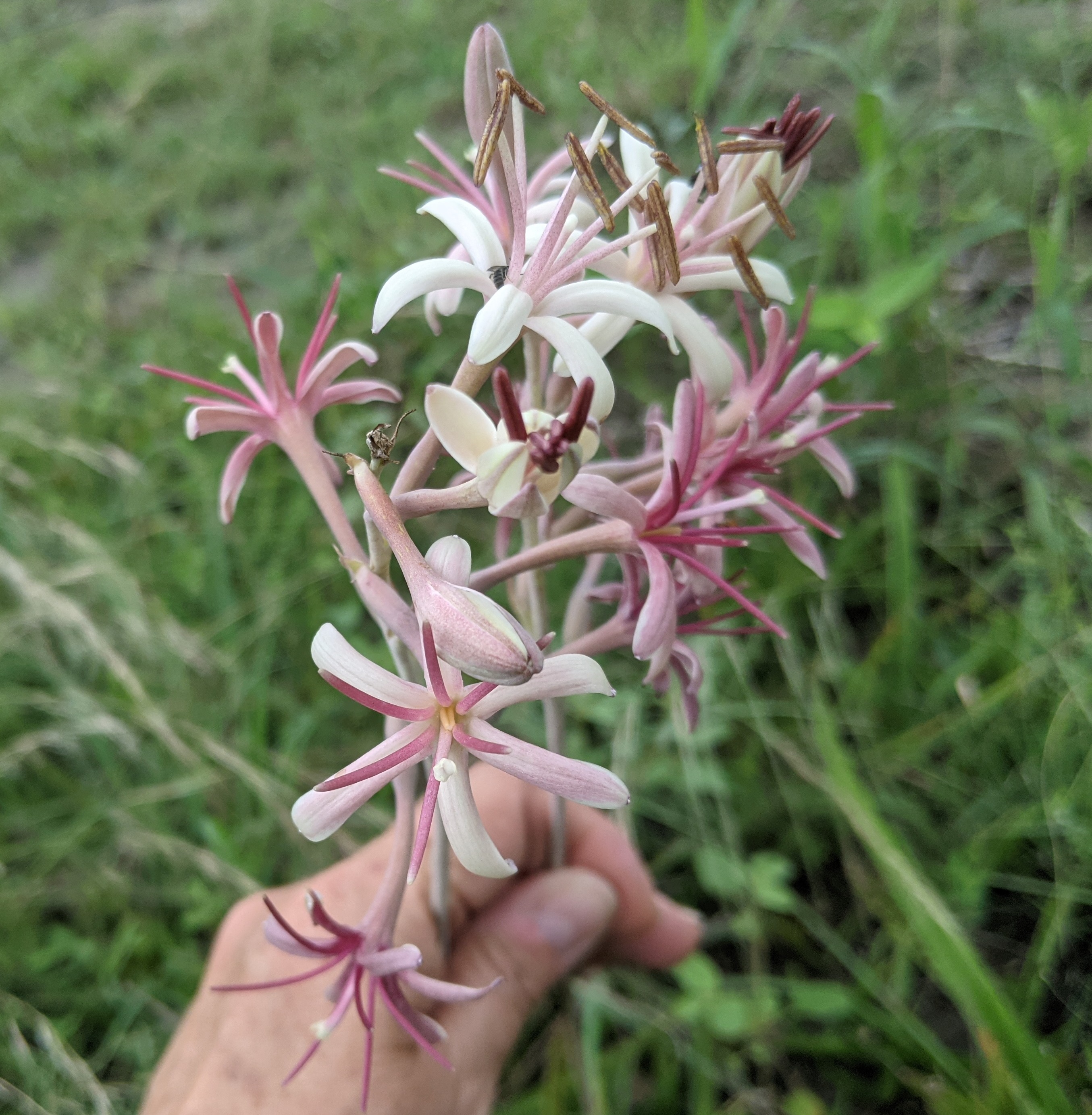
Searching South Texas for Succulent Tuberoses
As Published in American Butterflies, Summer/Fall 2022
Last September, Stephanie Lopez, who runs the native plant nursery at the National Butterfly Center, and I went on a little field trip. Well, I suppose I should say it was “little” by Texas standards, in that we only drove about 3 hours to get to our destination. If you’ve never made the trek to the tip o’ Texas, you may be unfamiliar with just how far south of South Texas the Rio Grande Valley really is; but, this nearly 200 mile excursion didn’t even take us to San Antonio, the geographical “gateway” to the rugged and romanticized, rattlesnake paradise that spills into the subtropics and reaches the border to Mexico, with whom we share culture, food, traditions, language and a colonial history longer than that of most of the United States. Here, near the edge of the ancient Giant Oyster (Crassostrea gigantissima) beds that lay where the Tejas Gulf Coast was once below sea level, the sandy soil, dense clay and salinity sustain habitat that is just right for another giant, the Manfreda Giant-Skipper. The succulent host for this almost-mythical butterfly is also called manfreda, cousin to the better-known agave.
While the Aztecs prized agaves as a gift from the gods, Jeffrey Glassberg treasures manfreda. Specifically, he elevates and desires two species, Spice Lily (spotted tuberose), Manfreda maculosa and Longflower Tuberose, Manfreda longiflora, the two known hosts for Manfreda Giant-Skipper, a globally, critically imperiled (G1) ranked butterfly.
Glassberg’s determination to save this species is a prime motivating factor in the North American Butterfly Association’s acquisition of Pixie Preserve, formerly, The Nature Conservancy’s Chihuahua Woods Preserve. This 350-acre property is close to the Rio Grande River to the south, and bordered by Ojo de Aqua (Eye of Water or Wellspring) Road to the west, as the delta winds toward the Laguna Madre. Although the river is naturally saline—about 1,000 parts per million at El Paso—the aquifer is even saltier, as evidenced by the sparkling crystals that shimmer on the topsoil at Pixie, where water bubbles to the surface and evaporates, especially in drought. In fact, both of these water sources are so salty (and becoming more so,) they cannot, technically, be classified as fresh water; but this seems to be what manfredas like best.
Historically, a copious population of manfreda could be found on the loma, or hill, at Pixie, where nitrate-rich silt is found atop caliche, a hardened natural cement of sand and gravel peculiar to semiarid regions. This sits above a layer of clay. Despite many attempts to locate manfreda, here, over the last several years, we’ve come up empty-handed; however, everything obvious about this environment says it is perfect for this persnickety plant, so, we continue to search…
And that is how Stephanie and I wound up traipsing along a rural highway, parallel to the Conquistador’s old Camino Real, with a merry band of Texas Master Naturalists, the U.S. Fish & Wildlife state botanist, a university professor and the county commissioner.
Now, let me back up. Glassberg has hounded me about manfreda, (both the butterfly and the plant,) for a decade, but they’re exceptionally hard to find and funding for work related to them has been nonexistent. Enter the James A. “Buddy” Davidson Charitable Foundation, associated with Texas Tech University in West Texas. For many years, the foundation has generously stepped in to supply the National Butterfly Center with funding for essential equipment, as well as agronomy-adjacent educational programs. For this reason, when they emailed in August of 2020, to say they had a little extra cash to distribute, I pitched the Manfreda Conservation Project, much to Glassberg’s delight. Even more delightful was the foundation’s decision to seed this foray, consisting of scouting, surveys, field observations, seed collection, propagation and the creation of test beds, all in the hope of augmenting or reintroducing both the plant and the butterfly to Pixie Preserve.
We began by expanding our research “on paper” into legacy and current, known populations of Manfreda maculosa and Manfreda longiflora. This meant reaching out to USFWS and Texas Parks and Wildlife Department’s botanists; tapping local experts, notably, Ken King the co-author of Plants of Deep South Texas; perusing iNaturalist; publicizing our quest; and engaging knowledgeable plant and butterfly people from Central Texas to the border, including NABA members, the Austin Butterfly Forum and TPWD’s former, invertebrate entomologist, Mike Quinn. Thanks to input from all of these excellent resources, we wound up expanding our geographical search area from 11 to 17 counties, and from 12 to an astounding 53 sites!
Of course, none of that would have been possible without the generous contributions of two, especially knowledgeable people and more than a dozen, dedicated volunteers. First, Chris Best, the state botanist for USFWS, created a priceless, guiding document, Manfreda Survey Instructions, for use by volunteers; and Camille Rich, a former teacher and current owner of El Mesteño Ranch, put together a brilliant, photographic tutorial on how to safely search for manfreda in the wild, based upon years of experience locating and observing it in the Tamaulipan thornscrub on her property.
Finding manfreda can be a most treacherous and challenging game of hide-and-seek, unless you’re well informed and prepared for the terrain, which is home to black widows, coral and rattlesnakes, Africanized bees and a wide variety of hostile, companion plants. The manfreda’s “growing buddies,” as Rich refers to them, are some of the most hazardous plants on the brushlands, and they have common names like prickly pear, Horse Crippler, Spanish dagger, pencil cactus and catclaw. If you’ve ever attended the annual Texas Butterfly Festival at the National Butterfly Center, you’ve probably heard me say, “Everything in South Texas fights for its life,” and manfreda is unique only in that it does not sting or tear one’s flesh; rather, it grows in the shadow of, and surrounds itself with, almost all of the ones that do! When searching for manfreda, any sign of this rogue’s gallery of stabbing succulents is a good one.
The viable range for manfreda is further narrowed by the typical presence of additional buddies, including Texas wild olive, and an evergreen group of drought-hearty trees and shrubs, namely Blackbrush Acacia, Colima (Lime Pricklyash), Guajillo and the highly-toxic host to the Two-barred Flasher, Coyotillo, which only grows in 32 Texas counties. Some of these counties get plenty of precipitation, so the manfreda grow well and are relatively easy to see in close proximity to their buddies. Although, in drought-affected areas, the manfreda dry up and retreat beneath the surface of the earth or go dormant, so they may be impossible to detect. In many cases, there may be just a portion of one or two little shoots peaking out, like creeping starfish arms, tentatively reaching to catch a bit of moisture and sunshine.
To help us cover as much ground as possible, we distributed a press release and call for volunteers to participate in the Manfreda Conservation Project to media outlets in 21 counties, as well as online and in our e-newsletter. Twenty-two people responded and nearly all of them logged on for our virtual trainings in March of 2021. Of course, the COVID-19 pandemic was still in bloom, with many not yet vaccinated; but our respondents were mainly couples or housemates, who felt comfortable venturing out together to survey the landscape, after being shut in for nearly a year.
Fortunately, many of them were also Texas Master Naturalists or knowledgeable outdoorsmen and women, so they were familiar with the places assigned to them, sometimes by site name, but also by GPS coordinates. As a result, everyone was ready to roll by April 1, 2021, for a survey and observation period we expected to last 6 – 8 weeks based upon manfreda’s normal, seasonal flowering cycle. However, we were thrown for a loop by Winter Storm Uri, which sent the entire state into a deep freeze that shocked or killed a lot of the plant life in manfreda’s very limited range.
Instead of running from April to June-ish, the project wound up running through early September. As our all-volunteer troops scoured cemeteries and state parks, public rights-of-way and private ranchlands, there were many disappointments, such as an absence of manfreda, like we’re seeing at the Pixie Preserve. Some of this may be from predation, as javelina voraciously consume manfreda as a thornless delicacy in a sea of needle-covered nourishment. Still, other sites were scraped, plowed under and paved as roadways were widened, or mowed for easement maintenance by government work crews.
There were some bright spots, though. One volunteer sent us a photo of a manfreda in flower with a towering stalk nearly as tall as a full-sized man. He was exuberant in emailing, “This is the tallest manfreda bloom stalk I’ve ever seen!” And the single greatest discovery was a patch of 959 “new” plants in Central Texas, which brings me back to where we started, with Stephanie and our happy, roadside search party.
True to Texas, as we walked too close to the fence line along private property a rifle rang out, firing a warning shot toward us wayward wanderers, lest we think about trespassing (which can be a capital crime in a castle doctrine state). In the distance, we could see a man standing beside his red Ranger ATV, with the rifle on his shoulder.
“Hey, Bill! It’s Tom!” yelled the elected official, arms outstretched overhead in an exaggerated wave, “Don’t shoot!”
The landowner approached the fence and his neighbors explained we were the folks they told him about, “the butterfly people” who came to see the rare plants growing between his fence and the road. From where Bill was standing, the plants didn’t seem rare, but we were obviously gobsmacked and grinning, especially since stands of 1,000 or more manfreda are reportedly required to sustain a population of Manfreda Giant-Skipper. This enormous stand had a “mirror” stand across the street, a little further down the road, where the fence line was obscured and overtaken by Texas persimmon. Both stands and the persimmon had gone to seed, so Chris Best, Christopher Gabler from the University of Texas-Rio Grande Valley, the local naturalists and Stephanie were all able to collect manfreda seed for the next phase of the project. Gabler also dug up soil samples for analysis, to find out as much as possible about the roadside conditions where this population was clearly thriving.
Since then, Best, Gabler, the naturalists and Stephanie have all managed to propagate manfreda and transplant it. At the National Butterfly Center, it’s going into six test beds with different soil composition, slope for drainage and sun exposure to see what may work best for a captive population, in the hope that we may be able to re-establish immense manfreda stands at Pixie and elsewhere. Gabler has also taken soil samples from Pixie to send to the lab for chemical analysis, including salinity, as this seems to be intensifying in the Rio Grande Valley, as the result of more concentrated, commercial agricultural practices, increasing population density and climate change.
Of course, the biggest disappointment of the survey period was the lack of evidence of Manfreda Giant-Skipper activity. No one observed chimneys used by larvae to climb the stalks or webbed tents on the leaves, and no one was lucky enough to encounter the butterfly that was presumed extirpated from the United States, until several years ago, when individuals were observed on private property by a scientist from North Texas.
In late August or early September, we hope to make the trek north, again, to check on this massive stash of host plants that might sustain the Manfreda Giant-Skipper, a natural treasure few have seen. If they can be saved, we hope to accomplish this in partnership with our members and partners, whose contributions to conservation continue to amaze! As always, we are grateful for their participation and the support of the James A. “Buddy” Davidson Charitable Foundation in this initiative, which is the first step in determining the extent to which this very special Texan still has a home here.
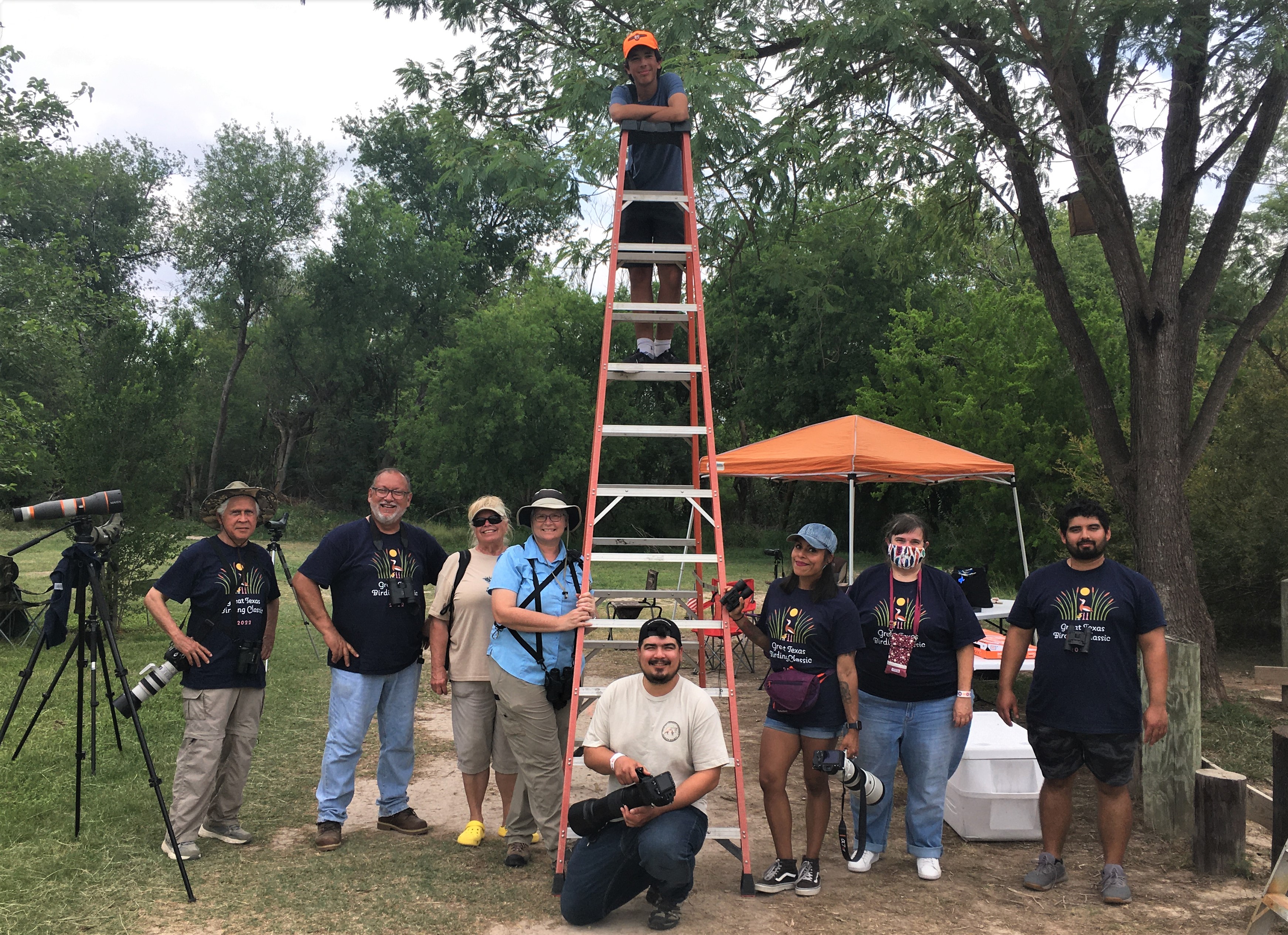
National Butterfly Center Wins the Texas Birding Classic Big Sit
(Mission, TX) – The National Butterfly Center’s team, Rock, Paper, Scissortails!, won the Big Sit Competition for the Lower Coast region in this year’s Great Texas Birding Classic with a total of 101 species, beating out tallies from teams representing world-renowned attractions, including the South Padre Island Birding and Nature Center, and Estero Llano Grande State Park and World Birding Center.
In the Big Sit, teams of birders each select a 50’ circle from which to bird by sight and by ear. They do so for up to a 24-hour period between the dates of April 15 and May 15. Then they submit their checklist to Texas Parks & Wildlife Department for review, and the team with the highest species count within each geographical region wins.
Luciano Guerra, Outreach & Education Coordinator for the National Butterfly Center, is the organizer and captain for the center’s team. Responsible for recruiting accomplished birders, selecting, preparing and supplying the circle site, and scheduling the day for the Big Sit, he says experience pays, when competing for this coveted title.
“This is the eighth year we’ve entered the Big Sit, but our first win!” explains Guerra, “I chalk it up to the fact that we’re continuously improving the location and condition of our count circle. I won’t give away any secrets, but if you want to win it helps to have fresh eyes and good ears on your team, and lots of refreshments for the birds and your teammates!”
It takes several weeks to gear up for this “big day” in birding, so the entire staff contributes to the success of the National Butterfly Center’s team. They all share in this success, with the 18 team members. In fact, two more employees actually served on the team, this year, even though the first shift began at 5 a.m. on May 1, before the crack of dawn, with the last shift clocking out close to 9 p.m. Throughout the day, team members braved swarms of mosquitoes, wind and sunburn, and frequent inquiries from visitors wondering what in the world they were up to.
“If the annual Texas Butterfly Festival is our ‘Super Bowl’,” states Marianna Trevino Wright, executive director of the center, “The Big Sit is our all-star game. Although the species are different, it’s our chance to show we are truly exceptional in the Rio Grande Valley—a place known for being the best of the best in the U.S.A. for butterfliers and birders.
“While other ‘nature centers’ aim to spend tens of millions of taxpayer dollars on creating artificial attractions,” adds Wright, “The National Butterfly Center let’s Nature be the star. Moreover, we do it on a shoestring budget because it’s about the plants, not the buildings.”
With more than 240 species of butterflies and almost 300 species of birds documented at the center, it has earned its status as a world-renowned destination for naturalists and nature tourists, alike, who journey to Mission, Texas, for a special ‘safari’ experience on the banks of the Rio Grande River.
To learn more about the National Butterfly Center, and how you can join us, visit www.nationalbutterflycenter.org. Your annual membership or charitable gift impacts the beauty of our community and helps preserve the biologically diverse, natural treasures of deep South Texas.
###
The National Butterfly Center is committed to ‘Growing Connections’ between people, plants, and the winged wonders that pollinate and propagate all that grows around us. We do this through educational and environmental initiatives that cultivate meaningful understanding of the processes that create sustainable ecosystems. The Center is open to the public, for visitors and members, seven days/week.
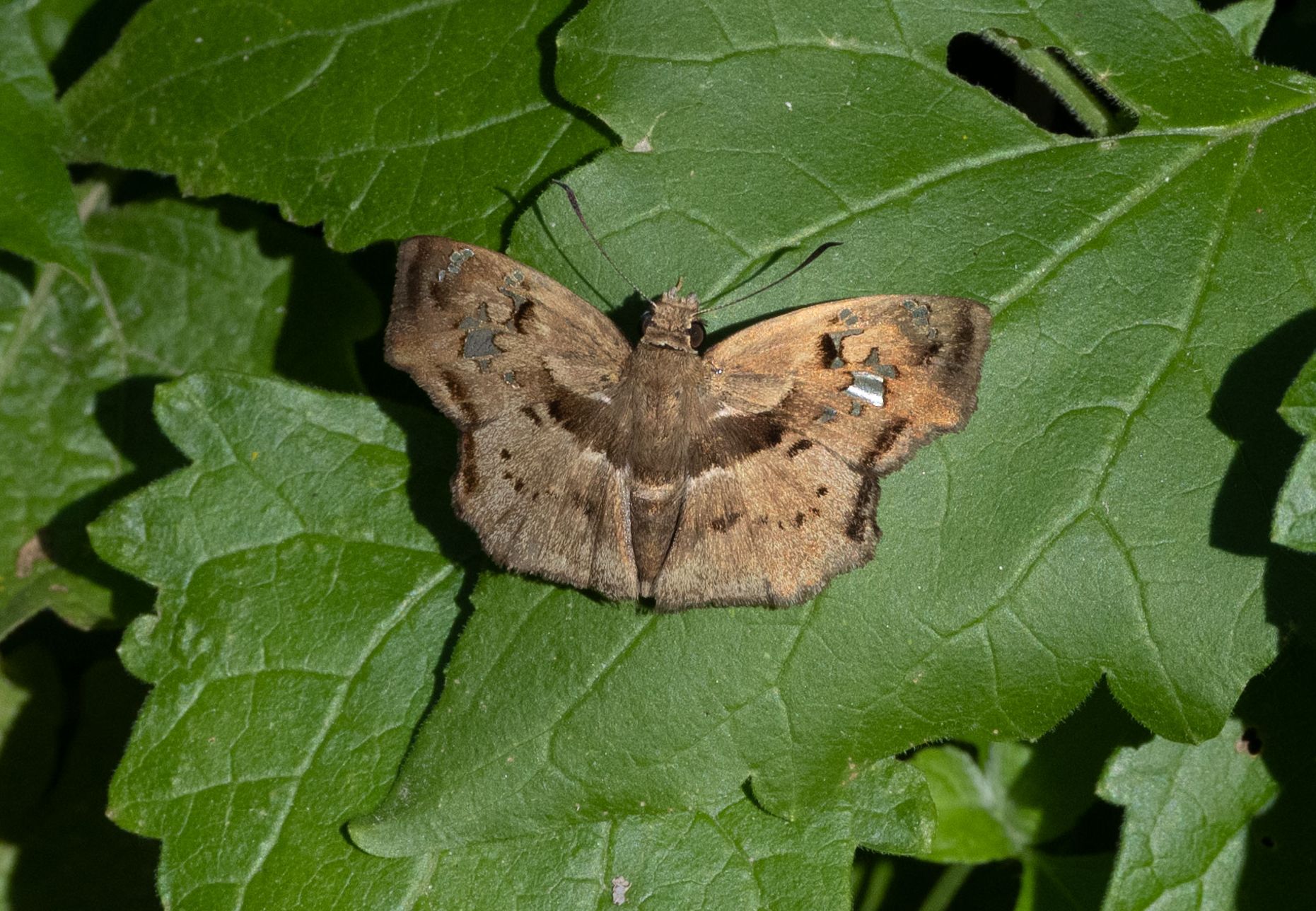
Record-Breaking Butterflies on Jan. 1 Symptom or Signal of Climate Change
(Mission, TX) – The new year began with an unprecedented “bloom” of butterflies at the National Butterfly Center in Mission, Texas, with a record-breaking 87 species documented for the day.
While the center has long been recognized for its remarkable volume and diversity of wild, free-flying butterflies, this unseasonal total on the first day of the new year is shocking the most seasoned of butterfliers.
Dr. Jeffrey Glassberg, president and founder of the North American Butterfly Association (NABA), which established the center in 2002, stated, “On a typical January day, one would expect to see about 25 species at the center, according to data NABA has collected over the last 20 years. This data set—the largest and longest running collection of butterfly counts across North America—is especially useful in establishing trends and evaluating anomalies, such as this.”
This exceptional occurrence at a truly exceptional place follows a year full of unusual weather events, starting with Winter Storm Uri in February, which brought a killing freeze to the Rio Grande Valley. Uri sent plants into shock and killed butterflies in all stages of their lifecycle. Then, Hidalgo County experienced the wettest June-July period since 1941, when official precipitation recording began.
Instead of welcoming regular rainfall, starting around Labor Day in September, the region was struck by a heat wave that lasted through the end of December, with this four-month period becoming the second hottest of all time. In addition, November saw rainfall more than three times the monthly average, and the last ten days of December registered temperatures 12-16° F above average.
On January 1, 2022, Mission, Texas reached a record-breaking 92° F, with the number of recorded butterfly species running just slightly behind this all-time high.
The National Butterfly Center sits at the northernmost edge of the neotropics in North America. While this area is uniquely hospitable to butterflies in a normal year, 2021—especially the last month—brought a multitude of migrants from the interior of Mexico and beyond. These very special “strays” include the first documented sighting of a Lugubrious Blue-Skipper in the United States at the National Butterfly Center in Mission, on Tuesday, December 28, 2021. Also spotted that same day was another spread-winged skipper, the ultra-rare Pale Sicklewing, and a Goodson’s Greenstreak, last photographed in the U.S. in 1994. In addition, Orion Cecropians and Pale-spotted Leafwings, commonly found in Central and South America, delighted visitors to the National Butterfly Center in deep South Texas.
“Butterflies are a key indicator of climate change,” asserts Glassberg. “Not only are their numbers declining in North America as a result of increased aridity due to climate change, but we see butterfly species rapidly ranging northward in response to the increasing warmth, especially in the winter. The relationship between butterflies and a warming world should be of peculiar interest to scientists, evolutionary biologists and climatologists, alike.”
To learn more about the National Butterfly Center, and how you can join us, visit www.nationalbutterflycenter.org. Your annual membership or charitable gift impacts the beauty of our community and helps preserve the biologically diverse, natural treasures of deep South Texas.
###
The National Butterfly Center is committed to ‘Growing Connections’ between people, plants, and the winged wonders that pollinate and propagate all that grows around us. We do this through educational and environmental initiatives that cultivate meaningful understanding of the processes that create sustainable ecosystems. The Center is open to the public, for visitors and members, seven days/week.
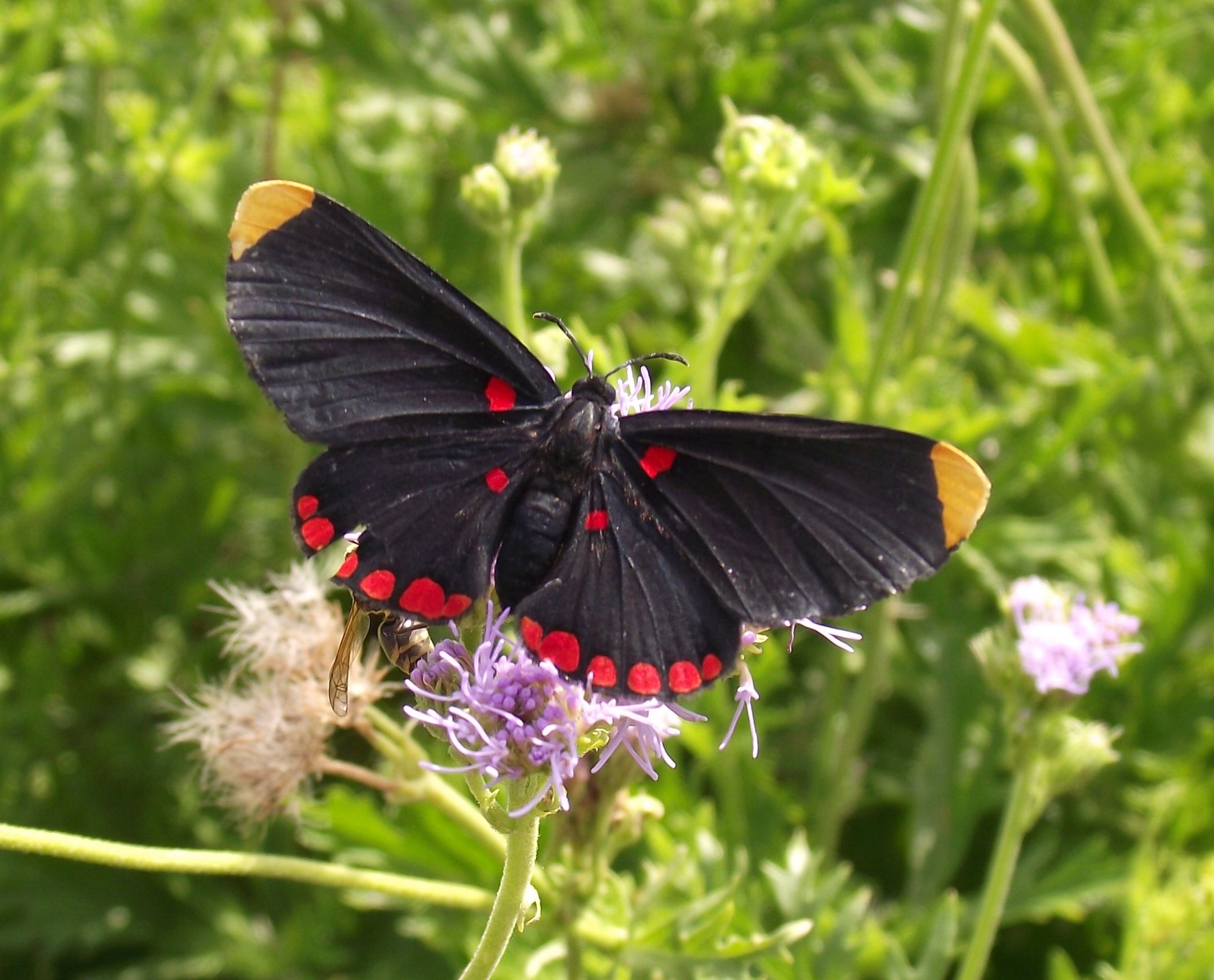
NABA Acquires Pixie Preserve
On April 12, 2019, Dr. Jeffrey Glassberg and I drove through the ominous gap in the border wall at Sabal Palm Sanctuary in Brownsville, Texas, to make a presentation to the spring meeting of the Texas Environmental Grantmakers Group. The group, consisting of key decision-makers from most of the environmentally-interested Texas foundations, had come to the Lower Rio Grande Valley because they were alarmed about the continuing destruction of irreplaceable habitat, now being exacerbated by the construction of border walls throughout the Valley.
Just two months earlier, in what Jeff refers to as the “Valentine’s Day Massacre,” U.S. District Court Judge Richard Leon summarily dismissed NABA's lawsuit against the Department of Homeland Security (DHS), without a single hearing; the 2019 DHS Spending Bill was enacted, exempting the National Butterfly Center (NBC) from border wall construction with congressionally appropriated monies; and President Trump declared a State of Emergency to “reprogram” funds from the U.S. Treasury and Department of Defense to build border wall that was not funded by Congress.
At this point, many were confused about the future of the Rio Grande Valley, already scarred by intermittent sections of concrete and steel “wall,” which stood as senseless monuments to the post-9/11 terrorism reflex of the Bush-Cheney years.
I can honestly tell you no one down here ever thought more border wall would be built inland from the mighty Rio Grande (or Rio Bravo, if you are on the Mexican side of the river), as it must be, given the lessons learned over the previous decade. We understood how harmful, absurd and ineffective it was from the heart-breaking recovery of hundreds of carapaces of drowned Texas Tortoises, trapped between the river and the wall during Hurricane Alex, to the ingenious images of jeeps driven up steep ramps erected to overcome the wall. Even the National Border Patrol Council had publicly declared border walls a waste of taxpayer money during President Obama’s terms, stating on a now-deleted webpage, “Walls and fences are only a speed bump. People who want to come to the United States to obtain employment will continue to go over, under, and around the walls and fences that are constructed.”
Still, in 2018 and 2019, Republicans AND Democrats in Congress voted to appropriate millions of dollars for dozens of new miles of border wall, with “enhanced technology,” all-night, bright, stadium lighting (that disrupts animal and plant circadian rhythms, leading to weakened populations and deaths), and a vastly expanded “enforcement zone,” with a high-speed, all-weather road. Adding further injury, the whole “border wall system” would be maintained devoid of vegetation with imazapyr, a broad-spectrum herbicide that is caustic and carcinogenic to humans and blinding to birds and mammals.
The theme of the grantmakers’ meeting was, “The Border Wall and the Ecology of South Texas.” Obviously, this was a friendly crowd of conservationists, interested in learning more about how more border wall might predictably impact the landscape; so, I spoke on behalf of the North American Butterfly Association (NABA) and the NBC. After all presenters were finished, we fielded questions from the attendees who were genuinely horrified.
One of my fellow presenters was Sonia Najera, Grasslands Program Manager for The Nature Conservancy. She left the meeting with Jeff and me, and casually asked, “Would you like to have Chihuahua Woods?”
If you know Jeff, you should not be surprised that he said, “Maybe.”
If you know me, you should not be surprised that I exclaimed, “Yes!”
Sonia looked at both of us, not knowing what to think. At that point, I am not sure we knew whether this would be a gift or a purchase, or some combination; still, we left Sonia with, “We’ll be in touch.”
I think Jeff and I “discussed” this prospect the whole drive back to the center, with him listing the cons and me the pros. Specifically, I knew Chihuahua Woods would give us options should the border wall bisect the National Butterfly Center, potentially cutting us off from the river, seventy acres and everything that has been planned for the future. Not that the center will ever be abandoned — which I think was Jeff’s greatest concern — but having another 350 acres (fifty acres of which are already behind the border wall) we could actively cultivate for butterflies opens up a whole lot of opportunity for growing connections; and that, after all, is our motto and our mission.
During that visit, (perhaps even the next day), Jeff went to check out Chihuahua Woods for himself. He was positively ebullient when came to tell me the property was fantastic and full of the most spectacular blooming cactus. Suddenly, he could see the appeal.
Indeed, the property has charm and potential, in spite of the ways in which it has been used in the past. For example, it is clear some of the land was subject to livestock grazing and subsistence farming. In addition, limestone or ‘caliche’ has been excavated for commercial sale and natural gas is still being extracted, here; and there are easements and disturbed rights-of-way for overhead powerlines and water delivery.
When Jeff went to see the property, the trails were overgrown or practically gone, and there was a lot of illegal dumping of household items, like mattresses and refrigerators, and “heavy trash,” including tires and construction debris, occurring around the perimeter. What worried him most, though, were legacy reports of “packs of wild dogs roaming” and unfortunate reports from people depicting the area as dangerous.
I have hiked Chihuahua Woods more than a couple handful of times in the last few years and I have never encountered dogs or danger. I have seen javelina and hawks; ground water bubbling up to the surface forming small springs; clouds of Lyside Sulphurs on flowering Texas Lignum-vitae (guayacan); and neighbors looking out for one another, curious to know what business I had coming around their humble community of Abram-Perezville in rural Hidalgo County, just 6 miles west of the National Butterfly Center.
To this day, I am not sure what won Jeff over, but on May 15, 2019, CNN and other major news outlets reported Jared Kushner claiming, “We solved the butterfly thing,” to a group of GOP Senators in a closed-door meeting regarding Trump’s priorities, and I was more convinced than ever that the center was NOT safe from land condemnation and border wall construction under the fake state of emergency.
Fast forward — just kidding, it was really more like slow-motion slogging through the COVID-19 pandemic and contract minutia — to April 2021, and NABA is now the proud owner of Chihuahua Woods, which we have renamed Pixie Preserve.
Although it is relatively close to the NBC, it seems a world apart. There is an old-growth ebony forest that is the last known nesting site of Hook-billed Kites in the United States. There is a barretal habitat that used to boast a large population of Longflower Tuberose, host plant for endangered Manfreda Giant-Skippers. There are a multitude of interesting native plants such as Jerusalem Thorn (palo verde), Saffron Plum (coma), Lotebush, Coyotillo, Brushland Shrubverbena (brushland lantana) and Crown of Thorns growing here that have never been very successful at the center, and last — but not least — more than three times the acreage to plant with a diversity of native host and nectar plants to support wild, free-flying butterflies.
Transforming Chihuahua Woods, which was closed and neglected, into a vibrant place for butterflies has begun in earnest! The county has been a big help in cleaning up the heavy trash, and we’re already tackling the overgrowth. Nestor is driving the big, blue tractor over once a week to mow, just so we can get to the trails in need of restoration. This winter, Stephanie and Denise started over 12,000 seedlings that like saline soil and compete well with Johnson grass and Kleberg Bluestem; and we’re looking for financial support to help us prepare the preserve for visitors.
Just walking around, noting what needs to be done and what may be new, provoked, perchance, to the surface by winter storm Uri, we’re also adding to the species inventory cataloged by The Nature Conservatory. Paula Sharp, author of the forthcoming compendium, Native Bees of Texas, is currently surveying the preserve; Luciano is photographing dragonflies, spiders, grasshoppers and mantids for identification; and I found this beautiful, six foot long Western Coachwhip near its recently shed skin on Easter Sunday.
If you’ve been a member of NABA since the inception of the National Butterfly Center in 2002, you know Pixie Preserve will be many more years in the making. Although certain “sensitive areas” of the property are off-limits for major alteration, the rest of the landscape is ripe for restoration. This is especially important as Hidalgo County’s population approaches one million people. To put that in perspective, if Hidalgo County was a state, it would be the 45th or 46th largest state in the union!
During his April 2021 visit, Jeff acknowledged Pixie Preserve and other NABA initiatives, like the public-private land conservation project for the Miami Blue, that place land into permanent conservation easement will be critical to saving butterflies and ourselves. With almost twenty incredible years invested in the fantastic experiment that is the National Butterfly Center, it is clear that educating people and equipping them to restore and rewild the land is just not enough — NABA and our members must take responsibility for more: We must create butterfly and native plant sanctuaries large enough to sustain species in meaningful numbers in order to advance our mission and accomplish our stated goal.
We are launching a capital campaign to fund improvements and facilities at Pixie Preserve this fall/winter, and hope you will consider making a year-end gift or a pledge for the new year toward this endeavor. A general contractor who’s done work for us at the NBC has offered his assistance with this design-build at no cost; so, we have draft plans for an environmentally-friendly, low-impact, (hopefully) LEED-certified, 2,720 square-foot building made of recycled shipping pods to house work and meeting space, more educational exhibits and restrooms. Although I mention the restrooms last, they are the most important feature of this facility, without which we cannot conduct school field trips — and youth education is the goal. In fact, we dream of doubling the number of students we serve each year from 6,000 to 12,000, once the preserve is fully open, for the love of butterflies.
I am more than excited to become the steward of this untamed place; to seek your support, so we may realize its potential; and to share this journey with you, for it would not be possible without you.
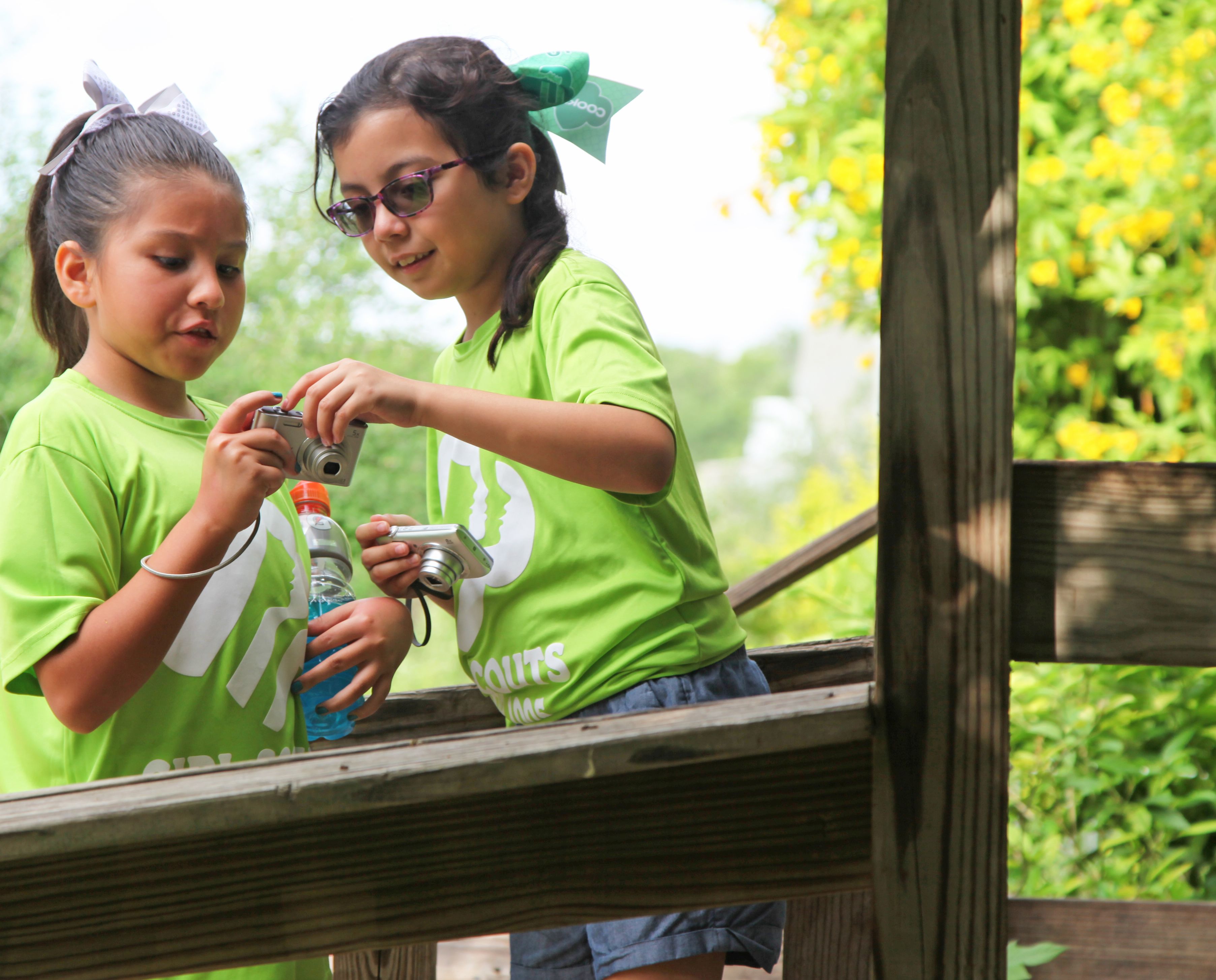
Latino Conservation Week Schedule of Activities at the NBC
(Mission, TX) – This Saturday, July 17, from 9 AM – Noon, the National Butterfly Center in Mission, Texas, will kick off its first full week of activities in celebration of Latino Conservation Week. Launched by the Hispanic Access Foundation, this annual event is intended to break down barriers for Latino communities to access public lands and waters, encourage new opportunities for engagement and inspire the next generation of environmental stewards.
Activities will be a mix of in-person and virtual events, for children and adults, with a focus on highlighting many of the creatures and features of the natural world that are central to vibrant communities and healthy families.
“The Rio Grande Valley is one of the most remarkable places in the nation,” asserts Marianna Treviño Wright, executive director of the National Butterfly Center. “We have a wealth of natural resources worth preserving, a burgeoning, brilliant population of young people, and a landscape that is rapidly changing due to population growth and economic development, some of which is exploitative and potentially harmful. So, we’ve put together a robust roster of environmental programs by educators and activists to shine a light on issues that are relevant to this region, with a nod to the past and a look toward the future.”
All of this week’s activities are free and open to the public. Virtual activities may be accessed online, regardless of physical location. Registration for virtual events, such as the poetry and expressive language workshop with 2020 Texas Poet Laureate Emmy Perez, and the EcoMadres introduction to the organization and legislative agenda, is required and available on Eventbrite, with links on the Home Page of the National Butterfly Center website. In-person events do not require registration, however, anyone over the age of 17 wishing to fish the Rio Grande on Saturday, July 24, must have a valid Texas Fishing License. Licenses are not necessary for children, and youth fishing poles will be provided along with basic angler education. For questions or assistance regarding any of the scheduled events, please call 956-583-5400 or email This email address is being protected from spambots. You need JavaScript enabled to view it..
Full Schedule: LATINO CONSERVATION WEEK at the National Butterfly Center
Saturday, July 17: OPEN HOUSE. 9 AM – Noon, Featuring:
"Wild RGV" with Texas Game Wardens
Marie Montalvo, Birding with Tia
Luciano Guerra, Conservation Photography with Chano
Camille Marie, “Magical” Plants of El Mesteño
Ernest Herrera, Bees Knees
Victoria Cappadona, South Texas’ Tree of Life
Stephanie Lopez, De Colores son las Flores
Nestor Gonzalez, Building a Better (Natural) World
Sunday, July 18: Young Voices in Conservation, 4 PM - 5 PM (VIRTUAL)
Speakers Panel with Naturalists Stephanie Lopez, Ernest Herrera, Giselle Garza & Alex Meza, regarding ‘green’ careers in conservation, education, and following your passion
Monday, July 19: The Beauty Before Us: Poetry from Nature Workshop with Emmy Perez, 2020 Texas State Poet Laureate, 6 - 7:30 PM (VIRTUAL)
6 - 7 PM (VIRTUAL) including a 2020-2021 Texas Legislative Session Update
Thursday, July 22: Ay Mariposa Documentary Screening at the National Butterfly Center, with Zulema Hernandez & Marianna Trevino Wright, 6:30 – 8 PM
Friday, July 23: Under the South Texas Sky: Night Hike, Black-lighting and Star-gazing, 8:30 - 10:00 PM
SUNDAY, July 24: Vamos a Pescar! (Fishing the Rio Grande), 8 - 10 AM
To learn more about the National Butterfly Center, and how you can join us, visit www.nationalbutterflycenter.org. Your annual membership or charitable gift impacts the beauty of our community and helps preserve the biologically diverse, natural treasures of deep South Texas.
###
The National Butterfly Center is committed to ‘Growing Connections’ between people, plants, and the winged wonders that pollinate and propagate all that grows around us. We do this through educational and environmental initiatives that cultivate meaningful understanding of the processes that create sustainable ecosystems. The Center is open to the public, for visitors and members, seven days/week.



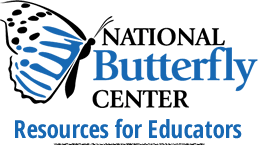



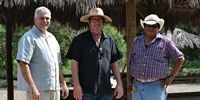

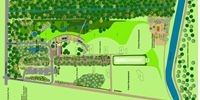
 Media
Media